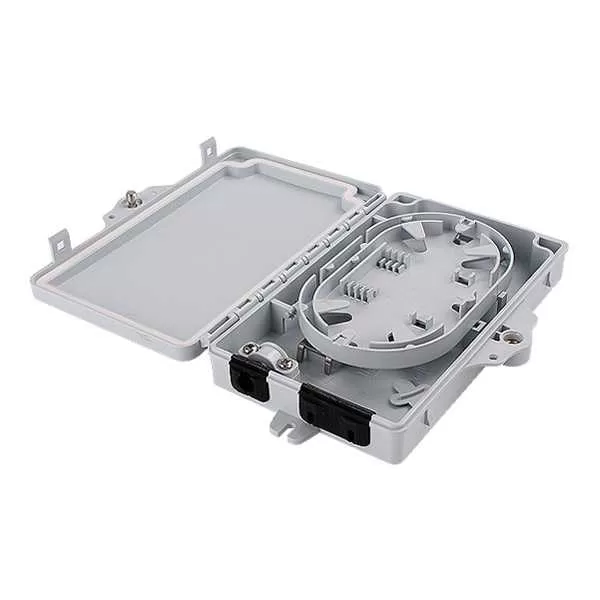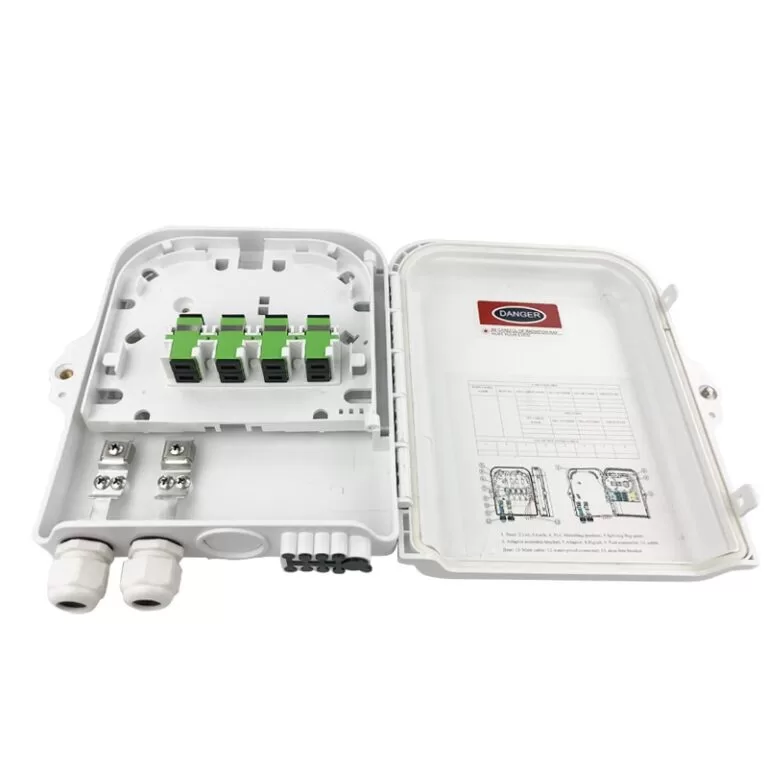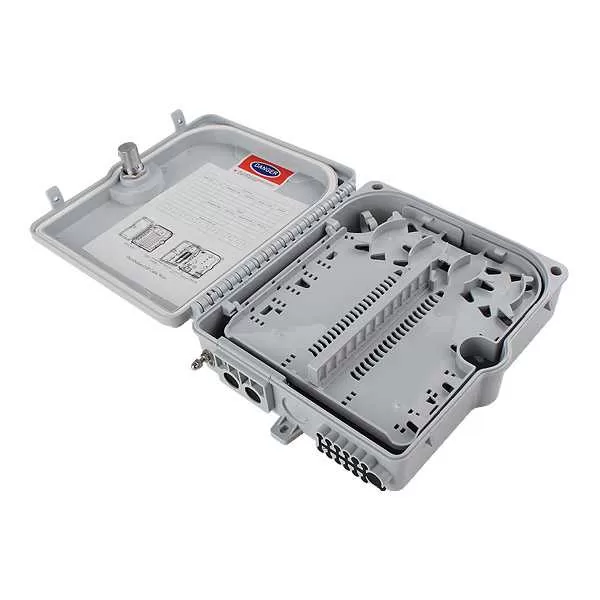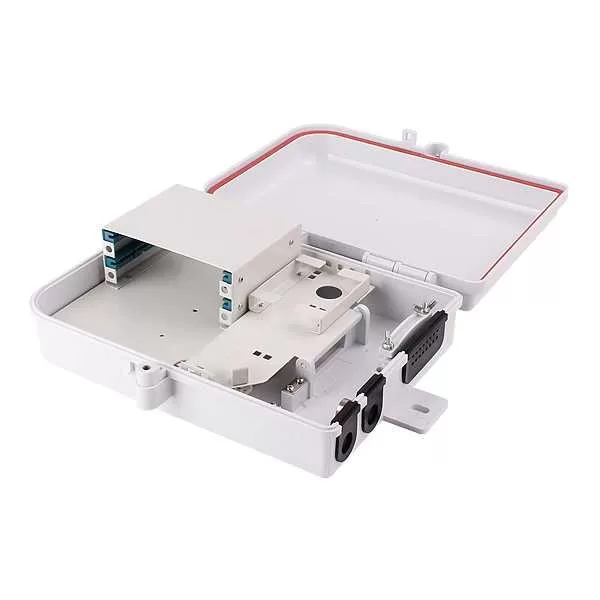Un montado en la pared caja de distribución de fibra óptica (FODB) es un componente pasivo de fibra óptica que se utiliza para terminar y distribuir cables de fibra óptica. Por lo general, se monta en una pared y proporciona un entorno protegido para empalmar y conectar cables de fibra óptica.






A continuación se muestra una comparación detallada de los diferentes recuentos de puertos de las cajas de distribución de fibra óptica montadas en la pared, centrándose en los beneficios y desventajas de cada recuento de puertos:
| Recuento de puertos | Beneficios | Desventajas |
|---|---|---|
| 2 puertos | Ideal para redes pequeñas con sólo unos pocos cables de fibra óptica; barato; Fácil de instalar y mantener | Puede que no tenga suficientes puertos para redes más grandes; Es posible que no tenga las funciones que necesita, como gestión de cables o bandejas de empalme. |
| 4 puertos | Buena opción para redes de tamaño mediano con pocos o varios cables de fibra óptica; más asequible que las cajas con mayor número de puertos; más fácil de instalar y mantener que las cajas con mayor número de puertos | Puede que no tenga suficientes puertos para redes más grandes; Es posible que no tenga las funciones que necesita, como gestión de cables o bandejas de empalme. |
| 6 puertos | Buena opción para redes medianas con varios cables de fibra óptica; más versátil que las cajas de 2 y 4 puertos; Más asequible que las cajas con mayor número de puertos. | Puede que no tenga suficientes puertos para redes más grandes; Es posible que no tenga las funciones que necesita, como gestión de cables o bandejas de empalme. |
| 8 puertos | Buena opción para redes medianas y grandes con varios o muchos cables de fibra óptica; más versátil que las cajas de 2, 4 y 6 puertos; Más asequible que las cajas con mayor número de puertos. | Puede que no tenga suficientes puertos para redes muy grandes; Es posible que no tenga las funciones que necesita, como gestión de cables o bandejas de empalme. |
| 12 puertos | Buena opción para redes grandes con muchos cables de fibra óptica; más versátil que las cajas de 2, 4, 6 y 8 puertos; pueden tener más funciones que las cajas con menor número de puertos, como gestión de cables o bandejas de empalme | Puede ser demasiado grande para redes pequeñas; puede ser más caro que las cajas con menor número de puertos |
| 24 puertos | Buena opción para redes grandes con muchos cables de fibra óptica; más versátil que las cajas de 2, 4, 6, 8 y 12 puertos; pueden tener más funciones que las cajas con menor número de puertos, como gestión de cables o bandejas de empalme | Puede ser demasiado grande para redes pequeñas y medianas; puede ser más caro que las cajas con menor número de puertos |
| 48 puertos | Buena opción para redes muy grandes con muchos cables de fibra óptica; opción más versátil; pueden tener más funciones que las cajas con menor número de puertos, como gestión de cables o bandejas de empalme | Puede ser demasiado grande para redes pequeñas, medianas y grandes; puede ser más caro que las cajas con menor número de puertos |
| 72 puerto | Buena opción para redes muy grandes con muchos cables de fibra óptica; opción más versátil; pueden tener más funciones que las cajas con menor número de puertos, como gestión de cables o bandejas de empalme | Puede ser demasiado grande para redes pequeñas, medianas y grandes; puede ser más caro que las cajas con menor número de puertos |
Beneficios de utilizar una caja de distribución de fibra óptica de pared:
- Ahorro de espacio: los FODB montados en la pared ahorran espacio en su ambiente interior.
- Fácil instalación y mantenimiento: los FODB de pared están diseñados para ser fáciles de instalar y mantener.
- Protección: Los FODB montados en la pared protegen sus cables de fibra óptica contra daños.
- Flexibilidad: los FODB montados en la pared se pueden utilizar en una variedad de aplicaciones, incluidas redes residenciales, comerciales y de centros de datos.
- Escalabilidad: Los FODB montados en la pared son escalables, lo que significa que pueden ampliarse para dar cabida a más cables de fibra óptica en el futuro.
Elegir la caja de distribución de fibra óptica de pared adecuada
Al elegir una caja de distribución de fibra óptica de pared, hay algunos factores a tener en cuenta:
- La cantidad de puertos que necesita: Los FODB montados en la pared están disponibles con una variedad de recuentos de puertos, así que elija uno que tenga la cantidad adecuada de puertos para sus necesidades.
- El tipo de cables de fibra óptica que está utilizando: Algunos FODB montados en la pared están diseñados para tipos específicos de cables de fibra óptica, como cables monomodo o multimodo. Asegúrese de elegir un FODB de pared que sea compatible con el tipo de cables de fibra óptica que está utilizando.
- Las características que necesitas: Algunos FODB montados en la pared vienen con características adicionales, como gestión de cables o bandejas de empalme. Considere las características que necesita y elija un FODB de pared que las tenga.
- Su presupuesto: Los FODB montados en la pared pueden tener un precio que oscila entre unos pocos cientos de dólares y varios miles de dólares. Elija un FODB de pared que se ajuste a su presupuesto.
Conclusión
Al elegir un montado en la pared caja de distribución de fibra óptica, es importante considerar el tamaño y la complejidad de su red, la cantidad de cables de fibra óptica que necesita terminar y distribuir, el tipo de cables de fibra óptica que está utilizando, la ubicación de montaje de la caja de distribución y el presupuesto. que tienes disponible.
FibraBarato ofrece una amplia variedad de FODB para elegir, incluidos FODB montados en la pared, FODB montados en bastidor y FODB para exteriores. Los FODB de FiberCheap están disponibles con una variedad de recuentos de puertos, para que pueda elegir el que mejor se adapte a sus necesidades.
Los FODB de FiberCheap están fabricados con materiales de alta calidad y están diseñados para durar. También están respaldados por una garantía, por lo que puede estar seguro de que obtendrá un producto de calidad.
Si está buscando un proveedor confiable y asequible de cajas de distribución de fibra óptica, FiberCheap es una excelente opción a considerar.
